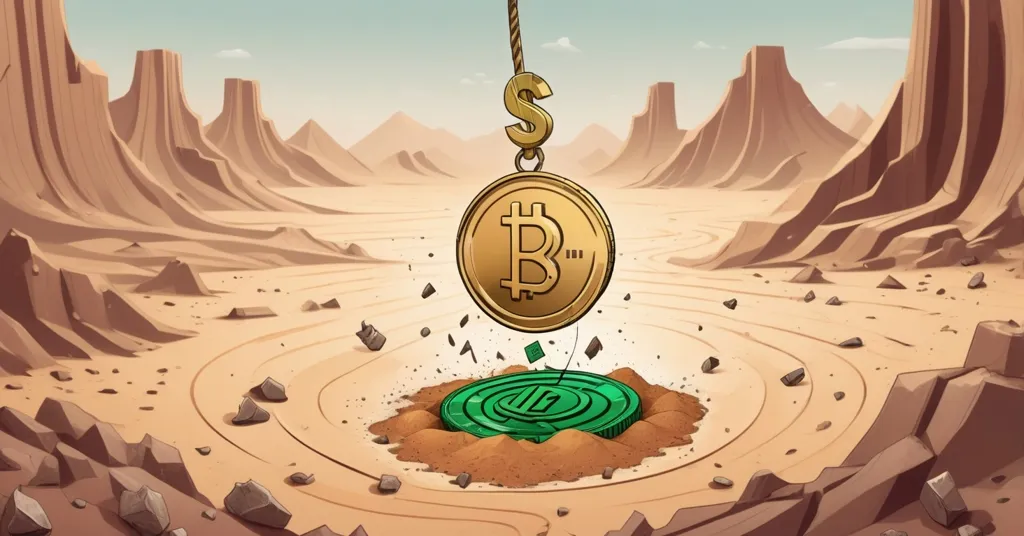Iran’s Harsh Stablecoin Limits: Crypto Crackdown as Rial Hits Record Low

Iran’s Harsh Stablecoin Caps: Crypto Crackdown Amid Rial Collapse
Iran’s economic nightmare has reached a new low as the government imposes severe restrictions on stablecoin transactions and holdings. With the national currency, the rial, in freefall and UN sanctions piling on pressure, the Central Bank of Iran is targeting a critical lifeline for citizens desperate to shield their savings from hyperinflation and navigate a strangled banking system.
- New Limits: Stablecoin purchases capped at $5,000 annually per person, holdings limited to $10,000.
- Compliance Window: One-month transition period to adjust to holding restrictions.
- Currency Crisis: Iranian rial at a record low of 1,136,500 to the US dollar, worsened by renewed sanctions.
Rial’s Collapse and the Stablecoin Surge
The Iranian rial has plummeted to an unprecedented 1,136,500 against the US dollar, a figure that spells disaster for ordinary citizens. This isn’t just a statistic—it’s a daily reality where savings vanish overnight due to hyperinflation, a situation where prices can double in mere days. Think of a loaf of bread costing a dollar today and two tomorrow; that’s the kind of economic chaos Iranians face. With renewed United Nations sanctions—stemming from longstanding tensions over Iran’s nuclear program and regional conflicts with the United States and Israel—cutting the country off from global banking systems like SWIFT, the formal financial infrastructure is virtually inaccessible for many. The result? A mass turn to stablecoins like Tether’s USDT, digital assets pegged to the US dollar, as a makeshift solution for stability and cross-border transactions.
What Are Stablecoins and Why Do They Matter?
For those new to the crypto space, stablecoins are a type of cryptocurrency designed to hold a steady value, usually tied to a stable asset like the US dollar. Imagine a digital version of a dollar that doesn’t lose its worth when your local currency tanks—that’s the appeal. Tether (USDT) and Circle’s USDC are leading examples, with USDT dominating in Iran due to its widespread use and liquidity. These aren’t speculative gambles like many altcoins; for Iranians, they’re a shield against a collapsing rial and a way to send money abroad or pay for imports without banks. In a sanctioned economy, stablecoins are often the only bridge to the outside world.
Government Crackdown: Caps and Consequences
Enter the Central Bank of Iran with a sledgehammer. The High Council has rolled out stringent caps on stablecoin activity, as declared by Asghar Abolhasani, Secretary of the High Council, in a recent announcement on stablecoin restrictions:
“From now on, the ceiling for purchasing stablecoins is set at $5,000 per user annually, and holdings cannot exceed $10,000.”
For those already holding more than the limit, there’s little breathing room:
“The important point is that regarding stablecoins currently in possession, a maximum one-month transition period has been set, during which the authorized ceiling for holdings must be observed.”
Why the heavy hand? The government is desperate to curb reliance on foreign currency alternatives and prop up the failing rial. Stablecoins, being pegged to the dollar, undermine state control over financial flows. By limiting their use, authorities hope to force citizens back into a system they can monitor. But here’s the rub: they’ve played this game before with physical dollars and gold, and it’s been a spectacular failure. Black markets thrived, the rial kept sliding, and public trust eroded further. Policing a decentralized ledger is a whole different beast—good luck with that, Tehran.
Picture an Iranian freelancer who gets paid in USDT by overseas clients. These caps mean they’re now forced to either break the law, cut their income, or dive into shadier corners of the crypto space. It’s not just a policy—it’s a direct hit to personal financial autonomy at a time when people are already drowning.
Beyond Stablecoins: Iran’s Crypto Mining Controversy
The stablecoin crackdown isn’t happening in a vacuum. Iran’s economic woes extend far beyond currency, with public anger simmering over systemic mismanagement and energy crises. Many locals point fingers at the Khamenei regime and connected elites, accusing them of hoarding scarce resources for profit while citizens endure blackouts. Crypto mining—the energy-intensive process behind Bitcoin and other blockchain networks—has become a lightning rod in this mess. Reports and residents link power shortages to mining farms, some allegedly tied to state interests, sucking the grid dry. Public demonstrations have even targeted these policies, with frustration boiling over into the streets.
Officials are quick to blame illegal miners for the outages, promising crackdowns. But let’s not pretend trust in these assurances is anything but paper-thin. Crypto mining is a convenient scapegoat for deeper failures—corruption, poor infrastructure, and policy flip-flops. Iran once legalized mining, lured by cheap subsidized electricity, only to reverse course when the grid couldn’t handle it. For every unlicensed operation they shut down, how many state-sanctioned farms keep humming along in the shadows? Blaming miners for blackouts is like blaming a flashlight for a hurricane—convenient, but absurd.
A Pattern of Inconsistent Crypto Policies
Iran’s relationship with cryptocurrency has been a rollercoaster. A few years back, the government embraced Bitcoin mining as a way to generate revenue and bypass sanctions, offering dirt-cheap electricity to attract operations. Fast forward to today, and mining is vilified as a drain on resources, while stablecoin users are painted as threats to national stability. This inconsistency breeds distrust. How can citizens take policies seriously when the state seems to change its tune based on whatever crisis is loudest? The irony is thick—blockchain tech, whether through mining or stablecoins, exposes a regime’s weaknesses, so it gets slapped with bans while the root issues fester.
Stablecoins vs. Bitcoin: Different Tools for Different Crises
As a Bitcoin maximalist, I’ll always argue that BTC is the ultimate middle finger to oppressive financial systems—a decentralized store of value free from state meddling. But I can’t ignore that stablecoins like USDT fill a gap Bitcoin doesn’t. BTC’s volatility makes it a lousy choice for day-to-day transactions; it’s a long-term bet on freedom and sound money. Stablecoins, for all their flaws—especially centralized ones like Tether with their murky backing—offer immediate stability. In a crisis zone like Iran, that’s not just useful; it’s survival. Need to pay for groceries or send cash to family abroad without the rial tanking mid-transfer? USDT has your back. Want a hedge against a regime’s collapse over a decade? That’s Bitcoin’s turf.
Could Iran’s crackdown push more toward Bitcoin despite its wild price swings? Possibly. But the caps on stablecoins might also drive users into riskier underground markets, where scams and theft lurk. Decentralization offers escape routes, sure, but black-market trading lacks recourse when things go south. For many Iranians, though, it’s a gamble worth taking over trusting a broken system.
Could There Be Legitimate State Concerns?
To play devil’s advocate, let’s consider the government’s side beyond just control. Stablecoins could, in theory, facilitate money laundering or tax evasion—issues any state would fret over. Anonymous transactions on blockchain networks make tracking illicit flows tricky. But let’s be real: in Iran’s context, these concerns feel like flimsy excuses against a backdrop of economic desperation. Most citizens aren’t laundering millions; they’re trying to buy bread or keep their savings from evaporating. If the state truly cared about illicit activity, they’d address the corruption and cartels many accuse of running rampant at the top. Targeting stablecoin users feels less like problem-solving and more like punishing the powerless.
Global Parallels: Crypto Under Siege
Iran isn’t alone in wrestling with blockchain’s disruptive power. China banned Bitcoin mining and transactions outright, citing energy and financial stability, only to see activity shift underground or overseas. India has toyed with crypto bans, backtracking under public and industry pushback. The common thread? Governments hate what they can’t control, especially when it offers citizens an exit from failing systems. Yet, decentralization keeps winning—users adapt, tech evolves, and state overreach often backfires. Iran’s stablecoin caps are just the latest battle in a global war between centralized power and blockchain freedom.
The Resilience of Decentralized Tech
Make no mistake, these restrictions are a symptom of a regime struggling to maintain control over an economy spiraling beyond repair. The rial’s collapse, fueled by sanctions and internal rot, isn’t something you fix by slapping limits on Tether USDT Iran adoption. If anything, this move will deepen distrust and push innovation further from regulators’ grasp. Blockchain and crypto are rooted in freedom—financial, personal, systemic. Iranians understand this better than most, having lived through decades of isolation and mismanagement. No arbitrary cap will kill the drive for autonomy; it’ll just change the battlefield. As governments worldwide grapple with crypto’s rise, one question looms: will decentralization always outpace control, or are we underestimating the state’s adaptability?
Key Questions on Iran’s Stablecoin Crackdown
- What are Iran’s new stablecoin restrictions and their impact on citizens?
Iran has limited annual stablecoin purchases to $5,000 and holdings to $10,000 per person, with a one-month compliance window. This restricts a vital tool for protecting savings from hyperinflation and bypassing banking sanctions, likely pushing transactions into risky underground markets. - Why is Iran targeting stablecoins like Tether USDT?
The government seeks to reduce reliance on dollar-pegged assets to bolster the failing rial, fearing a loss of financial control. Past efforts to curb dollars and gold failed, suggesting this crypto crackdown may also flop. - How does the rial’s collapse fuel stablecoin adoption in Iran?
With the rial at a historic low of 1,136,500 to the US dollar amid UN sanctions, stablecoins offer a stable alternative for savings and cross-border payments, acting as a lifeline in a broken economy. - What role does crypto mining play in Iran’s economic crisis?
Often blamed for energy shortages and blackouts, crypto mining serves as a scapegoat for deeper issues like corruption and mismanagement. Allegations of state-linked mining farms only fuel public anger. - Can Iran stop decentralized crypto tools like stablecoins and Bitcoin?
Doubtful. Decentralization thrives on resilience, and Iranians will likely find workarounds via underground markets, showcasing blockchain’s power to resist state overreach despite risks of fraud. - How do stablecoins differ from Bitcoin in crisis zones like Iran?
Stablecoins like USDT provide day-to-day stability for transactions, while Bitcoin, despite volatility, offers a long-term store of value and ideological resistance to control—both serve crucial, distinct roles.



